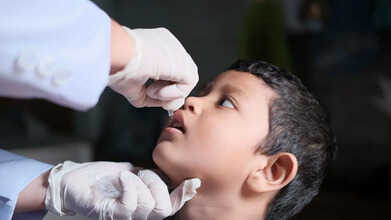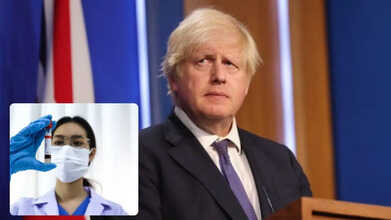- Health Conditions A-Z
- Health & Wellness
- Nutrition
- Fitness
- Health News
- Ayurveda
- Videos
- Medicine A-Z
- Parenting
- Web Stories
Over 6 Million Eggs Recalled In The US Over Salmonella Risk; What You Need to Know

Credits: Canva
Salmonella egg recall: The U.S. Food and Drug Administration (FDA) is urging people to avoid eating, selling, or serving certain eggs from the Black Sheep Egg Company. The Arkansas-based producer voluntarily recalled these eggs last month after concerns about possible Salmonella contamination. The recall, which began in late September, affects over six million eggs nationwide, according to FDA reports.
Which Egg Brands Were Recalled For Salmonella?
Black Sheep Egg Company supplies eggs to both wholesalers and retailers, and some of the recalled eggs may have been repackaged under different brands by other companies. Large shipments were also sent to restaurants and stores. As of October 17, the FDA reports that no illnesses have been linked to this recall.
Despite the recall, thousands of these eggs may still be on store shelves or sitting in your pantry. Here’s what you need to know to stay safe.
Recalled Eggs:
- Black Sheep Egg Company: 12-count cartons of free-range large Grade A brown eggs, best by dates: 8/22/2025–10/31/2025, UPC: 860010568507
- Black Sheep Egg Company: 18-count cartons of free-range large Grade A brown eggs, best by dates: 8/22/2025–10/31/2025, UPC: 860010568538
- Kenz Henz: 12-count cartons of Grade AA large pasture-raised eggs, best by dates: 10/11–10/14 and 10/16–10/17, UPC: 86949400030, sold in retail stores in Houston, TX
What Is Salmonella?
Salmonella refers to the illness caused by Salmonella bacteria, which typically leads to diarrhea, stomach cramps, and other digestive symptoms. This form of food poisoning, known as gastroenteritis, is the most common bacterial foodborne illness in the U.S.
To differentiate it from other diseases caused by different strains of Salmonella, such as typhoid fever, this type of infection is also called salmonellosis.
What Happens If You Get Salmonella?
A Salmonella infection occurs when enough bacteria survive your stomach acid and immune defenses to cause illness. Once inside, the bacteria invade and damage the cells lining your intestines. This interferes with your body’s ability to absorb water, leading to stomach cramps and watery diarrhea as your body tries to flush out the infection, as per Cleveland Clinic.
What Health Risks Do Salmonella-Contaminated Eggs Pose?
Salmonella-contaminated eggs can be particularly dangerous for children, older adults, and people with weakened immune systems. Eating these eggs may cause salmonellosis, with common symptoms including diarrhea, fever, and stomach cramps. In severe cases, the infection can require hospitalization and may even be life-threatening for high-risk individuals.
Recent outbreaks linked to contaminated eggs have affected several states, leading producers and retailers to issue recalls under guidance from the FDA and Centers for Disease Control.
Symptoms usually appear within six hours to six days after exposure and can become serious if dehydration or other complications occur. Public health officials recommend discarding recalled eggs, thoroughly washing hands and surfaces, and seeking medical attention if symptoms develop after consuming potentially contaminated eggs.
What to Do If You Have Recalled Eggs
The FDA advises that consumers, restaurants, and retailers should not eat, sell, or serve the recalled eggs. You can either return them to the store for a refund or safely dispose of them.
If you have unlabeled eggs in your fridge and aren’t sure whether they are part of the recall, it’s safest to discard them to avoid any risk of Salmonella infection.
World Polio Day 2025: Date, Theme, And Why Eradication Still Matters For Global Health

Credits: Canva
Polio is a contagious viral illness that can lead to paralysis, making its complete eradication important to protect every child from lifelong disability, a mission recognised each year on World Polio Day. This global observance aims to spread awareness about the dangers of polio and the continued worldwide push to end the disease.
The day also serves as a platform for governments, health organisations, and communities to reflect on the progress achieved so far, identify ongoing challenges, and strengthen collective efforts toward a polio-free world. Let’s take a look at when World Polio Day is observed and what this year’s theme focuses on.
Why Is World Polio Day Celebrated?
World Polio Day, observed every year on October 24, aims to raise global awareness about the importance of eradicating polio and maintaining immunization efforts. Recognized by organizations such as the World Health Organization, Rotary International, and UNICEF, the day celebrates the progress made against polio while highlighting the work still needed to protect children from this potentially life-threatening disease.
It brings together governments, communities, educators, and health workers in a shared effort to support a polio-free world, underscoring the power of vaccination and the importance of collective action in public health.
World Polio Day: History and Origin
World Polio Day was created to honor Dr. Jonas Salk, who developed the first effective poliomyelitis vaccine. The observance was officially initiated by Rotary International and is now supported by the Global Polio Eradication Initiative (GPEI), which includes key partners like WHO and UNICEF. The day not only commemorates vaccine breakthroughs but also continues the global fight to end polio, a disease that once paralyzed hundreds of thousands of children annually. Thanks to worldwide vaccination campaigns, most of the world is now polio-free, though efforts continue in regions where the virus still exists.
World Polio Day 2025 Theme
This year’s theme, End Polio: Every Child, Every Vaccine, Everywhere, emphasizes the urgent need to vaccinate every child and ensure equal access to protection against polio. It is a call to action for global eradication, highlighting both the responsibility and commitment required to make a polio-free world a reality.
How Does Polio Spread?
Polio is mainly transmitted through the faecal-oral route, meaning it spreads when a person consumes food or water contaminated with the virus. It can also spread through close contact with an infected individual. The poliovirus lives in the throat and intestines of those infected, and poor sanitation, unsafe water, and inadequate hygiene greatly increase the risk of transmission, especially in communities with limited access to clean facilities.
In severe cases, polio can lead to acute flaccid paralysis, which may affect the diaphragm and throat muscles, making it difficult to breathe or swallow. Since there is no cure for polio, prevention remains the only line of defence. Raising awareness about polio vaccination is therefore essential to protect individuals, especially children, from this potentially life-threatening disease.
Kim Kardashian Hints at Brain Aneurysm After Stressful Divorce; What Is It and How Serious Is It?

Credits: Kim Kardashian Instagram/Canva
Kim kardashian brain aneurysm: Kim Kardashian has revealed that a routine MRI detected a small brain aneurysm, which doctors linked to the stress of her divorce from Kanye West. The 45-year-old reality TV star shared the news on the season seven premiere of The Kardashians while talking with her sister, Kourtney Kardashian, 46. “They found a little aneurysm,” Kim said, prompting a visibly shocked Kourtney to place her hand over her chest and respond: “Whoa.” Here’s a closer look at what this condition involves and how serious it can be.
Kim Kardashian Hints at Brain Aneurysm After Stressful Divorce
Kim Kardashian, the 45-year-old lifestyle influencer and entrepreneur, recently shared a startling health update on her reality show The Kardashians. During a conversation with her sister on season seven, the SKIMS founder revealed that a brain scan had detected a “little” aneurysm. She reportedly attributed it to the stress of her divorce from rapper Kanye West, the father of her daughter, North.
What Is A Brain Aneurysm?
A brain aneurysm, also called a cerebral or intracranial aneurysm, is a weak or thin spot in the wall of a blood vessel in the brain that balloons out and fills with blood. Many aneurysms remain unruptured and asymptomatic for years, but if they rupture, they can cause a life-threatening stroke known as a subarachnoid haemorrhage, according to the National Library of Medicine. The Mayo Clinic notes that about 85% of aneurysms are found in the brain’s anterior circulation.
Certain individuals are at higher risk, including those with hypertension, genetic disorders, a family history of aneurysms, regular smokers, heavy alcohol users, or infections that affect blood vessels (mycotic aneurysms). Plaque buildup in artery walls can also increase the risk, according to the National Institutes of Health.
What Is A ‘Little’ Brain Aneurysm?
Brain aneurysms are relatively common, but most are not serious, especially if they are small. The majority of aneurysms do not rupture and often do not cause symptoms or health problems. Many are discovered incidentally during scans for unrelated conditions, just like Kim Kardashian’s was found during her routine MRI.
When Kim referred to a “little” brain aneurysm, she meant a small aneurysm, typically under 3 millimeters, which is far less likely to rupture. These tiny, unruptured aneurysms usually produce no symptoms and are often detected by chance during imaging for other medical reasons.
Early Warning Signs Of An Aneurysm
Most brain aneurysms go unnoticed until they leak or rupture. However, as they expand, they can press on nearby nerves, producing early warning signs. Neurologists at the Mayo Clinic list potential symptoms such as persistent, localized headaches often behind the eyes or in the temples, blurred or double vision, and pain behind the eye. Other signs may include a drooping eyelid, unequal pupil size, facial weakness or numbness, slurred speech, and balance problems.
Is A Brain Aneurysm Serious?
Brain aneurysms can be serious, but it largely depends on their size and location. Many small aneurysms, like Kim Kardashian’s “little” one, often remain harmless and may never rupture.
While Kim Kardashian found out about her condition during a routine MRI, doctors can also spot aneurysms through an angiography, which helps detect any unruptured bulges in blood vessels. These are more frequently seen in women between 30 and 60 years old, and when combined with other risk factors, this group is considered higher risk. Physicians recommend managing blood pressure, quitting smoking, and keeping a close watch on vascular health as preventive steps.
UK Covid Inquiry: Why Is It Investigating Government Decisions During the Pandemic

Credits: Canva
While the term coronavirus is no longer part of our daily conversations, the investigation into how the UK handled the pandemic is still ongoing. The respiratory illness that first appeared in Wuhan, China, at the end of 2019 led the UK into two years of unprecedented lockdowns beginning in March 2020. By the end of 2023, there had been more than 235,000 COVID-related deaths in the UK, with countless others left grieving, dealing with long-term health effects, or facing financial difficulties.
The COVID inquiry was created to examine the decisions made during the crisis and assess how they affected everyday life across the country. Below, we explore what exactly the Covid inquiry is and why Boris Johnson is currently appearing before it.
What Is The Covid Public Inquiry And When Did It Start?
Boris Johnson launched the Covid inquiry in June 2022, over a year after promising that the government’s pandemic response would be “put under the microscope,” according to the BBC. The announcement followed pressure from the Covid-19 Bereaved Families for Justice campaign, which had considered pursuing a judicial review over what it called government “delays.”
Johnson stated that the inquiry would review decisions made not only by the UK government but also by the administrations in Scotland, Wales, and Northern Ireland. The first public hearings were held in London in June 2023, with subsequent sessions in Edinburgh, Cardiff, and Belfast.
Public inquiries are set up and funded by the government but are led by an independent chair. They have the authority to require witnesses to provide evidence. They do not determine guilt or innocence, but instead publish conclusions and recommendations, which the government is not required to implement.
Who Is Leading The Covid Inquiry?
The inquiry is chaired by Baroness Hallett, a former judge and crossbench peer who previously oversaw the inquests into the 7 July London bombings. She has emphasised that the inquiry will place loss and suffering at its centre and assured that it would remain “firmly independent.”
What Is The Inquiry Looking At?
The inquiry is divided into multiple modules. The first, which examined resilience and preparedness, has concluded, but investigations continue in several other areas:
- Decision-making and political governance in Westminster, Scotland, Wales, and Northern Ireland
- Impact on healthcare systems across the UK
- Vaccines, therapeutics, and antiviral treatments
- Government procurement and PPE
- The care sector
- Test-and-trace programmes
- The effect on children and young people
- Government business and financial interventions
- Broader societal impact
There is no fixed timetable for when the inquiry will conclude.
What Has Been Published So Far?
The report on the first module was released in July 2024. It spans 83,000 words and draws from 103,000 submitted documents and 213 witness statements from 68 individuals. The report concluded that UK citizens were “failed” by the state, particularly due to shortcomings in planning, processes, and civil contingency structures within the UK government and devolved administrations.
It noted that the government had prepared for the “wrong pandemic,” focusing on influenza rather than coronaviruses, and suggested that some of the financial and human costs might have been avoided had the focus been different.
Boris Johnson And Covid Enquiry
When former Prime Minister Boris Johnson gave evidence in late 2023, he expressed regret for the “pain, loss, and suffering” caused by the pandemic, though his remarks were interrupted by protesters holding signs that read: “The dead can’t hear your apologies.” Johnson acknowledged personal responsibility for decisions made and admitted that the government “may have made mistakes,” while emphasising that it had done its “level best” to respond to the virus.
He was questioned about meeting notes from 19 March 2020 in which he had reportedly asked why the government was “destroying everything for people who will die soon anyway,” referring to “bed blockers.” Johnson explained that the messages were not intended for public release but reflected the “cruelty of the choice” he faced and the “difficult balancing act” required during the pandemic.
He also admitted that the severity of the virus should have been recognised before March 2020, apologised for previously dismissing long COVID as “b*******,” and described media coverage of ‘partygate’ as “dramatic.”
Boris Johnson’s Current Module In Covid Enquiry
On Tuesday, former Prime Minister Boris Johnson denied that his government had failed to adequately prepare for the “horror” of school closures during the COVID-19 crisis but apologised for mistakes made. This marked his second appearance before the inquiry he had agreed to establish after pressure from bereaved families. Two years ago, he defended himself against claims that his failure to heed scientific advice contributed to unnecessary deaths.
During this recent session, Johnson conceded that the UK government “probably did go too far” with some Covid-19 restrictions and admitted that children bore a “huge, huge price” during the pandemic. He told the inquiry that while ministers and officials were focused on tackling an “appalling public health crisis” in early 2020, the measures taken were, in hindsight, “far too elaborate.”
© 2024 Bennett, Coleman & Company Limited

